3 March 1999
Wellington and Kaikoura, New Zealand
On the Road and Ocean, at Last
After twelve days in Wellington, and with it looking like things on
the Kaharoa were just about ready to get underway, it was finally
time for us to head down to Kaikoura. Although our time in Wellington
was quite productive, we were all quite
anxious to begin the "in-water" part of the expedition.
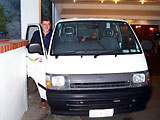 There were a number of ways we could have made the trip to Kaikoura, but since there
was a great deal of expedition-related equipment to carry down and
realizing that we would be needing some form of transportation while in
Kaikoura, Clyde, Ingrid, Mike Sweeney and I piled ourselves and all of the
gear into the white NIWA van at 7:30 this morning and headed off for the ferry.
Actually, "ferries" would be the more accurate term. Because the
trip across Cook Strait is so popular at this time of the year (being
summer in New Zealand), the only way that we were able to get across
was to place the van on one ferry (the Suilvan, which is primarily a
cargo transport) and ourselves on another (the Arahura, a passenger,
rail and car ferry).
There were a number of ways we could have made the trip to Kaikoura, but since there
was a great deal of expedition-related equipment to carry down and
realizing that we would be needing some form of transportation while in
Kaikoura, Clyde, Ingrid, Mike Sweeney and I piled ourselves and all of the
gear into the white NIWA van at 7:30 this morning and headed off for the ferry.
Actually, "ferries" would be the more accurate term. Because the
trip across Cook Strait is so popular at this time of the year (being
summer in New Zealand), the only way that we were able to get across
was to place the van on one ferry (the Suilvan, which is primarily a
cargo transport) and ourselves on another (the Arahura, a passenger,
rail and car ferry).
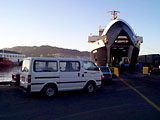 Maneuvering through the early morning rush hour
of downtown Wellington, Clyde easily arrived at the Suilvan with time to
spare and we entrusted all of our worldly possessions to the man at the
ferry dock. We had to leave to catch our ferry before we actually got to
see them load our van onto the Suilvan, but nobody seemed to be at all
concerned....except perhaps, me. Having been stranded more times than
I care to remember, I decided to keep the two most important things
by my side rather than leave them on the van. So with digital camera
and laptop computer in hand, we headed off to begin the next phase
of the expedition.
Maneuvering through the early morning rush hour
of downtown Wellington, Clyde easily arrived at the Suilvan with time to
spare and we entrusted all of our worldly possessions to the man at the
ferry dock. We had to leave to catch our ferry before we actually got to
see them load our van onto the Suilvan, but nobody seemed to be at all
concerned....except perhaps, me. Having been stranded more times than
I care to remember, I decided to keep the two most important things
by my side rather than leave them on the van. So with digital camera
and laptop computer in hand, we headed off to begin the next phase
of the expedition.
We took a taxi over to the Interislander ferry terminal which looked more
like an airport or railway station than the ferry terminals that I am used
to here in the States.
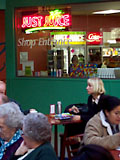 Having arrived earlier than most, we managed to
find ourselves some seats and grabbed a bite to eat in the small cafe.
The ferry Arahura (a Maori word meaning "Pathway to Dawn"), arrived a
few minutes later and little by little the terminal began to fill with people until there
was barely enough room to stand. At 9:00 the loudspeaker announced that
general boarding was about to begin and a great mass of humanity started to move towards
the entry doors.
Having arrived earlier than most, we managed to
find ourselves some seats and grabbed a bite to eat in the small cafe.
The ferry Arahura (a Maori word meaning "Pathway to Dawn"), arrived a
few minutes later and little by little the terminal began to fill with people until there
was barely enough room to stand. At 9:00 the loudspeaker announced that
general boarding was about to begin and a great mass of humanity started to move towards
the entry doors.
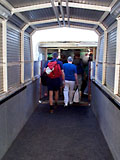 The doors opened and people, many of whom had obviously
been on the ferry before, rushed across the gangway and into the ship in hopes
of finding the best seats for the three hour crossing of Cook Strait. Since Clyde
had made this trip before, we followed him up to Deck 7 and into the Queen
Charlotte Lounge, where we happily collapsed into four wonderfully comfortable
easy chairs overlooking the bow. Well, they would have overlooked the bow if
we had been able to see out the windows, but the salt spray from the last crossing
had all but obliterated any hope that we had of getting a clear view.
The doors opened and people, many of whom had obviously
been on the ferry before, rushed across the gangway and into the ship in hopes
of finding the best seats for the three hour crossing of Cook Strait. Since Clyde
had made this trip before, we followed him up to Deck 7 and into the Queen
Charlotte Lounge, where we happily collapsed into four wonderfully comfortable
easy chairs overlooking the bow. Well, they would have overlooked the bow if
we had been able to see out the windows, but the salt spray from the last crossing
had all but obliterated any hope that we had of getting a clear view.

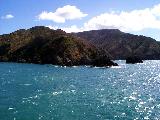 At 9:30 exactly, the ship's horn sounded, the docklines cast off and we were
underway. The Arahura is a very large ferry and can carry nearly 1000
passengers, 60 railway cars and over 100 automobiles. In addition to the wonderful
scenery that is available, there were plenty of places to eat, a small movie
theatre showing children's films, video arcades and even a small room filled
with mechanical poker machines....for those who wanted to test their luck.
Our group opted to enjoy the spectacular views of the headlands of the North
Island and just as we made our way out into Cook Strait, we overtook the slower
steaming Suilvan which hopefully had our van on board.
At 9:30 exactly, the ship's horn sounded, the docklines cast off and we were
underway. The Arahura is a very large ferry and can carry nearly 1000
passengers, 60 railway cars and over 100 automobiles. In addition to the wonderful
scenery that is available, there were plenty of places to eat, a small movie
theatre showing children's films, video arcades and even a small room filled
with mechanical poker machines....for those who wanted to test their luck.
Our group opted to enjoy the spectacular views of the headlands of the North
Island and just as we made our way out into Cook Strait, we overtook the slower
steaming Suilvan which hopefully had our van on board.
Cook Strait can often be a very rough stretch of water with winds and waves
combining to make the crossing potentially miserable. Thankfully, Neptune was
smiling favorably on us today and with nothing more than a long, gentle swell
to let us know that we were actually at sea rather than sitting in a fine hotel,
we made the crossing without incident. Thinking that the journey was nearly
over, I was quite surprised to see that we still had a long way to go before
we reached Picton, our destination.
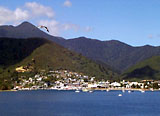
 Winding our way through narrow inlets
with steep, pine covered hillsides along either bank, we passed small communities
nestled along the shore until we finally saw the little town of Picton. Having
sailed through the San Juan Islands in the Pacific Northwest, I couldn't help but
think that I had passed this way before. Even the smell of the cold ocean spray
mixed with the scent of pine was the same. It was only the wonderful New Zealand
accents that I heard behind me that made me realize that I was indeed half a world
away. The Arahura docked and we walked over to the other wharf to await the
arrival of the Suilvan. While we waited on end of the pier for the ferry, Clyde
struck up a conversation with one of the local fishermen about yes, you guessed
it........squid. Was it fate or just coincidence that this fisherman was using squid as
his bait of choice? If I believed in omens I would certainly have felt that this was
a good one.
Winding our way through narrow inlets
with steep, pine covered hillsides along either bank, we passed small communities
nestled along the shore until we finally saw the little town of Picton. Having
sailed through the San Juan Islands in the Pacific Northwest, I couldn't help but
think that I had passed this way before. Even the smell of the cold ocean spray
mixed with the scent of pine was the same. It was only the wonderful New Zealand
accents that I heard behind me that made me realize that I was indeed half a world
away. The Arahura docked and we walked over to the other wharf to await the
arrival of the Suilvan. While we waited on end of the pier for the ferry, Clyde
struck up a conversation with one of the local fishermen about yes, you guessed
it........squid. Was it fate or just coincidence that this fisherman was using squid as
his bait of choice? If I believed in omens I would certainly have felt that this was
a good one.
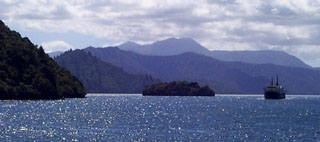
Within thirty minutes of our arrival, we saw the Suilvan come steaming around the
headland and was soon docked alongside the wharf. Much to my relief, the third vehicle to
be offloaded was our van. Mike and Clyde got into the front while Ingrid and I made
ourselves comfortable in the back feeling a little like we were being carted off to
prison for some horrific offense. We couldn't decide, however, whether the wire
screen separating the front from the rear was for Mike and Clyde's protection, or
for ours.

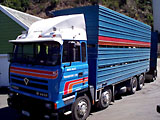
 I don't know the exact numbers but I think that New Zealand has a population
of something approaching 4 million people. I do believe, however, that the number of sheep
probably far exceeds the number of people. Sheep were everywhere...in the fields,
on the hillsides, in people's backyards and riding along the roads and in the
ferries on large, multi-tiered transport trucks. It was difficult to look at them staring
out at us from the trucks as we passed each other along the way.
I don't know the exact numbers but I think that New Zealand has a population
of something approaching 4 million people. I do believe, however, that the number of sheep
probably far exceeds the number of people. Sheep were everywhere...in the fields,
on the hillsides, in people's backyards and riding along the roads and in the
ferries on large, multi-tiered transport trucks. It was difficult to look at them staring
out at us from the trucks as we passed each other along the way.
 As we made out way down the coast through the towns of Blenheim and Seddon, we
came over a hill and there, off in the distance we saw what looked like a giant pink lake.
As we got closer we could see stretching out before us a patchwork quilt of different
colored ponds; some white, some green and the most unusual of all, pink. Realizing that
this was a natural solar saltworks (using the sun to evaporate sea water that is
trapped in shallow ponds leaving behind the salt), we decided that this would be something
worth stopping to investigate. We stopped by the office of the
Dominion Salt Ltd. where
we were given a lesson in salt production. It turns out that Lake Grassmere was the
ideal location to build a salt making facility (it was started back in 1943) because:
As we made out way down the coast through the towns of Blenheim and Seddon, we
came over a hill and there, off in the distance we saw what looked like a giant pink lake.
As we got closer we could see stretching out before us a patchwork quilt of different
colored ponds; some white, some green and the most unusual of all, pink. Realizing that
this was a natural solar saltworks (using the sun to evaporate sea water that is
trapped in shallow ponds leaving behind the salt), we decided that this would be something
worth stopping to investigate. We stopped by the office of the
Dominion Salt Ltd. where
we were given a lesson in salt production. It turns out that Lake Grassmere was the
ideal location to build a salt making facility (it was started back in 1943) because:
- It had a large area of flat land with impervious soils located on the coast
- The land was unsuitable for most other uses
- The region has the lowest rainfall in all of New Zealand
- Strong winds and constant sunshine give rise to very high evaporation rates.
 The operation was enormous with the main sea water concentrating lake being over
1700 acres in size. Huge mounds of glistening white salt were constantly being added
to by the seemingly never-ending supply of salt pouring off the conveyor belts. Warehouses
were filled from floor to ceiling with giant bags filled with salt to be used in everything
from domestic table salt, to the tanning of hides and skins and to make up all those salt-lick
blocks that so many farm animals need.
The operation was enormous with the main sea water concentrating lake being over
1700 acres in size. Huge mounds of glistening white salt were constantly being added
to by the seemingly never-ending supply of salt pouring off the conveyor belts. Warehouses
were filled from floor to ceiling with giant bags filled with salt to be used in everything
from domestic table salt, to the tanning of hides and skins and to make up all those salt-lick
blocks that so many farm animals need.
Getting back to the the original reason we stopped, we learned that the pink
coloration in some of the ponds was due to the abundance in very large numbers
of a microscopic unicellular algae. Normally algae are green (I will be talking
more about this in a later journal), but when they grow in the highly concentrated
saline brine of the salt ponds, a red pigment known as haematochrome is formed
coloring the waters pink. According to the folks at the salt works, this is the
reason why the Red Sea got its name.
 After a short stop for lunch we finally reached our destination. Kaikoura sits along a
narrow corridor of land between the foothills of the extensive mountain
range that runs along the east coast of the South Island of New Zealand and the Pacific
Ocean. The unique oceanographic conditions of this region help make the waters off
Kaikoura home to a wide variety of marine life including dolphins, fur seals, countless
seabirds and fish and the two most formidable inhabitants - the sperm whale and
the giant squid.
After a short stop for lunch we finally reached our destination. Kaikoura sits along a
narrow corridor of land between the foothills of the extensive mountain
range that runs along the east coast of the South Island of New Zealand and the Pacific
Ocean. The unique oceanographic conditions of this region help make the waters off
Kaikoura home to a wide variety of marine life including dolphins, fur seals, countless
seabirds and fish and the two most formidable inhabitants - the sperm whale and
the giant squid.
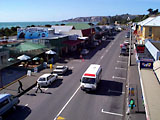 Driving along the Esplanade, the road that hugs the beach for the length of
the town, we found the motel that was going to be the base of operations
for the next few weeks of the expedition. Alan and Linda Rees, the proprietors
of the Sierra Beach Front Motel made us feel instantly at home and presented
each of us with a glass bottle of milk to take to our rooms. I was not sure
if this was a custom unique to this motel, to the town of Kaikoura or to the
country in general but it was a nice gesture nevertheless. Bernard Brennan,
the member of our expedition who is conducting bio-acoustical research on the
sperm whales of Kaikoura had been here for almost two weeks and had turned his
room into a makeshift electronics laboratory.
Once we unpacked the van and began to settle into our rooms, we each did something that made the
place feel more like home.
Driving along the Esplanade, the road that hugs the beach for the length of
the town, we found the motel that was going to be the base of operations
for the next few weeks of the expedition. Alan and Linda Rees, the proprietors
of the Sierra Beach Front Motel made us feel instantly at home and presented
each of us with a glass bottle of milk to take to our rooms. I was not sure
if this was a custom unique to this motel, to the town of Kaikoura or to the
country in general but it was a nice gesture nevertheless. Bernard Brennan,
the member of our expedition who is conducting bio-acoustical research on the
sperm whales of Kaikoura had been here for almost two weeks and had turned his
room into a makeshift electronics laboratory.
Once we unpacked the van and began to settle into our rooms, we each did something that made the
place feel more like home.
 For Clyde and Ingrid it was the act of hoisting the
Smithsonian flag outside their door and hanging a large purple kite that was
in the shape of a squid on their window. For Mike it was to sacrifice his table
so that Clyde and Ingrid could have a place to work in their room. And for me,
it was sitting down on the porch, taking out my laptop and starting to record
these thoughts while they were still fresh in my mind.
For Clyde and Ingrid it was the act of hoisting the
Smithsonian flag outside their door and hanging a large purple kite that was
in the shape of a squid on their window. For Mike it was to sacrifice his table
so that Clyde and Ingrid could have a place to work in their room. And for me,
it was sitting down on the porch, taking out my laptop and starting to record
these thoughts while they were still fresh in my mind.
regards,
gene
<-- Previous Journal | Next Journal -->
 Having arrived earlier than most, we managed to
find ourselves some seats and grabbed a bite to eat in the small cafe.
The ferry Arahura (a Maori word meaning "Pathway to Dawn"), arrived a
few minutes later and little by little the terminal began to fill with people until there
was barely enough room to stand. At 9:00 the loudspeaker announced that
general boarding was about to begin and a great mass of humanity started to move towards
the entry doors.
Having arrived earlier than most, we managed to
find ourselves some seats and grabbed a bite to eat in the small cafe.
The ferry Arahura (a Maori word meaning "Pathway to Dawn"), arrived a
few minutes later and little by little the terminal began to fill with people until there
was barely enough room to stand. At 9:00 the loudspeaker announced that
general boarding was about to begin and a great mass of humanity started to move towards
the entry doors.
 The doors opened and people, many of whom had obviously
been on the ferry before, rushed across the gangway and into the ship in hopes
of finding the best seats for the three hour crossing of Cook Strait. Since Clyde
had made this trip before, we followed him up to Deck 7 and into the Queen
Charlotte Lounge, where we happily collapsed into four wonderfully comfortable
easy chairs overlooking the bow. Well, they would have overlooked the bow if
we had been able to see out the windows, but the salt spray from the last crossing
had all but obliterated any hope that we had of getting a clear view.
The doors opened and people, many of whom had obviously
been on the ferry before, rushed across the gangway and into the ship in hopes
of finding the best seats for the three hour crossing of Cook Strait. Since Clyde
had made this trip before, we followed him up to Deck 7 and into the Queen
Charlotte Lounge, where we happily collapsed into four wonderfully comfortable
easy chairs overlooking the bow. Well, they would have overlooked the bow if
we had been able to see out the windows, but the salt spray from the last crossing
had all but obliterated any hope that we had of getting a clear view.
 There were a number of ways we could have made the trip to Kaikoura, but since there
was a great deal of expedition-related equipment to carry down and
realizing that we would be needing some form of transportation while in
Kaikoura, Clyde, Ingrid, Mike Sweeney and I piled ourselves and all of the
gear into the white NIWA van at 7:30 this morning and headed off for the ferry.
Actually, "ferries" would be the more accurate term. Because the
trip across Cook Strait is so popular at this time of the year (being
summer in New Zealand), the only way that we were able to get across
was to place the van on one ferry (the Suilvan, which is primarily a
cargo transport) and ourselves on another (the Arahura, a passenger,
rail and car ferry).
There were a number of ways we could have made the trip to Kaikoura, but since there
was a great deal of expedition-related equipment to carry down and
realizing that we would be needing some form of transportation while in
Kaikoura, Clyde, Ingrid, Mike Sweeney and I piled ourselves and all of the
gear into the white NIWA van at 7:30 this morning and headed off for the ferry.
Actually, "ferries" would be the more accurate term. Because the
trip across Cook Strait is so popular at this time of the year (being
summer in New Zealand), the only way that we were able to get across
was to place the van on one ferry (the Suilvan, which is primarily a
cargo transport) and ourselves on another (the Arahura, a passenger,
rail and car ferry).
 Maneuvering through the early morning rush hour
of downtown Wellington, Clyde easily arrived at the Suilvan with time to
spare and we entrusted all of our worldly possessions to the man at the
ferry dock. We had to leave to catch our ferry before we actually got to
see them load our van onto the Suilvan, but nobody seemed to be at all
concerned....except perhaps, me. Having been stranded more times than
I care to remember, I decided to keep the two most important things
by my side rather than leave them on the van. So with digital camera
and laptop computer in hand, we headed off to begin the next phase
of the expedition.
Maneuvering through the early morning rush hour
of downtown Wellington, Clyde easily arrived at the Suilvan with time to
spare and we entrusted all of our worldly possessions to the man at the
ferry dock. We had to leave to catch our ferry before we actually got to
see them load our van onto the Suilvan, but nobody seemed to be at all
concerned....except perhaps, me. Having been stranded more times than
I care to remember, I decided to keep the two most important things
by my side rather than leave them on the van. So with digital camera
and laptop computer in hand, we headed off to begin the next phase
of the expedition.









 The operation was enormous with the main sea water concentrating lake being over
1700 acres in size. Huge mounds of glistening white salt were constantly being added
to by the seemingly never-ending supply of salt pouring off the conveyor belts. Warehouses
were filled from floor to ceiling with giant bags filled with salt to be used in everything
from domestic table salt, to the tanning of hides and skins and to make up all those salt-lick
blocks that so many farm animals need.
The operation was enormous with the main sea water concentrating lake being over
1700 acres in size. Huge mounds of glistening white salt were constantly being added
to by the seemingly never-ending supply of salt pouring off the conveyor belts. Warehouses
were filled from floor to ceiling with giant bags filled with salt to be used in everything
from domestic table salt, to the tanning of hides and skins and to make up all those salt-lick
blocks that so many farm animals need.


